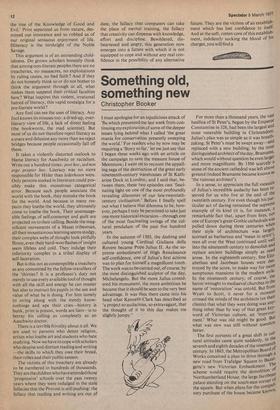Something old, something new
Christopher Booker
I must apologise for an injudicious attack of 'flu which prevented me last week from continuing my exploration of some of the deeper issues lying behind what I called 'the great mania for conservation presently sweeping the world.' For readers who by now may be requiring a 'Story so far,' let me just say that I began three weeks ago with an article on the campaign to save the treasure house of Mentmore; I went on to recount the appalling saga of the destruction of the great early nineteenth-century warehouses of St Katharine Dock in London ; and I said that, between them, these two episodes cast 'fascinating light on one of the most profoundly revealing dilemmas of our late-twentiethcentury civilisation.' Before I finally spell out what I believe that dilemma to be, however, perhaps I may be permitted to take just one more historical excursion—through one of the most fascinating swings of the cultural pendulum of the past five hundred years.
In the autumn of 1503, the dashing and cultured young Cardinal Giuliana della Rovere became Pope Julius II. As the supreme embodiment of High Renaissance self-confidence, one of Julius's first actions was to plan for himself a magnificent tomb. The work was to be carried out, of course, by the most distinguished sculptor of the day, Michelangelo. But the more Julius considered his monument, the more ambitious he became that it should be seen to the very best advantage. It was thus there came into his head what Kenneth Clark has described as 'a project so audacious, so extravagant, that the thought of it to this day makes me slightly jumpy.' For more than a thousand years, the vast basilica of St Peter's, begun by the Emperor Constantine in 326, had been the largest and most venerable building in Christendom. Julius's plan was as simple as it was breath .taking. St Peter's must be swept away—and replaced with a new building, by the most distinguished architect of the day, Bramante, which would without question be even larger and more magnificent. By 1506 scarcelY a stone of the ancient cathedral was left above ground (indeed Bramante became known as 'the ruinous architect').
In a sense, to appreciate the full measure of Julius's incredible audacity has been re' served for us who live at the end of the twentieth century. For even though his Par" ticular act of daring remained the suprerne example of its kind (it is, for instance, a remarkable fact that, apart from fires, tint one of Europe's great Gothic cathedrals was pulled down during three centuries when their style of architecture was largelY scorned as barbarous and 'mean in spirit)' men all over the West continued until well into the nineteenth century to demolish and replace ancient buildings simply as need arose. In the eighteenth century, fine Elizabethan and Jacobean houses were destroyed by the score, to make way for more sumptuous mansions in the modern style. In the nineteenth century, of course, the havoc wrought to mediaeval churches in the name of 'restoration' was untold. But from Wyatt to Scott, it never for a moment crossed the minds of the architects (or their clients) that what they were doing was anything other than by way of that great keYword of Victorian culture, an ',irnprove ment.' What was old might be good. But what was new was still without question better. The first portents of a great shift in cultural attitudes came quite suddenly, in the seventh and eighth decades of the nineteenth_ century. In 1865, the Metropolitan Board ol Works conceived a plan to drive through .a new road from Trafalgar Square to Baialgette's new Victorian Embankment. The, scheme would require the demolition 0i Northumberland House, the large Jacobean, palace standing on the south-east corner the square. But when plans for the comPw sory purchase of the house became known,
It was not only the Duke of Northumberland who was enraged. There was also a howl of protest against the pulling down of this fine old building from the public at large.
It was a profoundly significant moment. In fact, after a fire in 1868, the scheme for the new Northumberland Avenue did eventually go through, and the house was demolished in 1875. But in the same year, the destruction of the Oxford Arms, a galleried sixteenth-century coaching inn near St Paul's, prompted the foundation of a Society for the Photographing of Old Buildings. In 1877, alarmed by the rate at which old churches were giving way under the onslaught of Victorian 'restoration,' William Morris founded the Society for the Protection of Ancient Buildings. Sir John Lubbock began his annual attempts to bring in an Act for the preservation of ancient monuments which, when it was finally approved in 1882, laid the foundation for the Whole of our elaborate structure for the legal Protection of 'listed' buildings today. For the first time in history, in short, men were beginning to feel such an affection for old buildings, for their own sake, that they were actually prepared to battle to save them. Even so, for nearly a century longer, desRite the ever-growing nostalgia for old buildings, the conviction still remained that on the whole to pull buildings down to replace them with something 'better' was still quite natural and desirable. In the 1920s, Nash's Regent Street, one of the finest of nineteenthcentury townscapes, was swept away almost Without a thought. In the 1930s, only the coming of war prevented the similar destruction by Sir Reginald Blomfield of the Nash terraces in The Mall. To today's reader, one of the most startling things about that celebrated book Thin Face of London by Harold Clunn (published in the 1930s) is the relentless way in which any large development of those times (the 'splendid' new Sbell-Mex building, the 'magnificent' new ICI block on Millbank) was still automaticallY looked on as a mark of ever-onward, ever
oPward progress.
in fact this underlying sense of confidence survived until remarkably lately. Certainly t ilrcnigh the first two decades after the Second World War, despite the steady r°wth in legislative protection of outstanding gems, despite the odd public furore over an Imperial Institute or a Euston Arch, we embarked on the greatest transformation °,,nr cities had ever known, with tower blocks and 'comprehensive redevelopment schemes' and the new technological style in a_rcbitecture, with a confident abandon that nuld almost have done justice to Julius II c Then suddenly, in the late-1960s, came the °IlaPse. Within just a few years, the great conservation' movement mushroomed into ° ,ne of the most powerful social forces of the age. For the first time we had seen the future, and it did not work. Our architectural and cultural self-confidence disintegrated with quire astonishing speed. From Michelangel°'s Rome to Britain in the late 1970s, the
pendulum has finally swung its full arc.
And so we arrive at the extraordinary dilemma we are in today. Firstly, far from believing that anything new is better, we are now (generally) convinced of almost exactly the reverse—that anything new is worse, and that almost any old building should be preserved at all costs. So total is our lack of confidence in our ability to design, to plan, even to build properly, that we are now prepared to revere almost any building from 'the past'—not just masterpieces, or Georgian terraces, but grim Victorian warehouses, factories, back-to-back jerry-built Victorian slums, even the serried ranks of suburban semis of the 1920s and 1930s.
But secondly, and here is the rub, as our society continues to change with great speed, old buildings still continue to outlive their original uses. Churches, railway stations, warehouses, town halls, country houses continue to become redundant, or 'uneconomical' in ever greater numbers. But just as we can no longer bear to think of anything old being pulled down, so we desperately switch all our architectural skills, our resources and our cultural ingenuity to adapting these old structures to new uses. Churches become concert halls, warehouses become 'World Trade Centres,' country houses become museums (or 'garden centres' or 'equestrian centres'), Cotswold tithe barns become trendy restaurants. Yet, in some mysterious way, almost every time the trick is performed, something of the essential spirit of the old building vanishes. As one wanders round the beautifully restored fragments of what survives of St Katharine Dock, the eighteenth-century timber-framed warehouse transformed into a trendy pub, across the twee little 'authentic' cobblestones, one is no longer in a grim survival of nineteenthcentury commerce, but a sub-Williamsburg fantasy world. Even some of our great cathedrals which in the past twenty years have been lovingly restored, and cleaned, and floodlit have (for my taste at least) been transformed into little more than beautiful, soulless film sets.
We are, in short, finally stuck, trapped in our wonderful, comfortable, late-twentiethcentury material prison. We can neither build anew with faith in the future nor can we preserve the past that we love by artificial means, and yet preserve that intangible thing about it which we feel our civilisation has mysteriously lost. But here I believe we are confronted with the heart of the cultural crisis which in the past few years has finally crept up on our civilisation without our being fully aware of it. It is something which runs much deeper and wider than mere considerations of architecture. It is certainly wrapped up with the quite startling collapse of the modern movement in all the arts (which has happened so suddenly that most people have not yet even noticed it). It is something which certainly extends back as far as the Renaissance, where we began. But once again, I fear, I must reserve my concluding thoughts on this mighty theme for a further article next week.



































 Previous page
Previous page